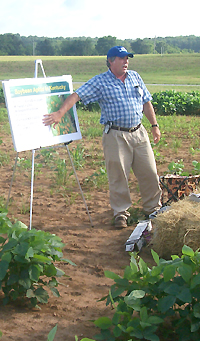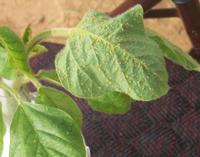UK Research Focuses on Soybean Aphid
UK Research Focuses on Soybean Aphid

Soybean aphids are beginning to be found in soybean fields across the state and farmers are being advised to scout for this new pest.
 The aphids first began appearing in Kentucky in 2000 and were found throughout the state last year in low numbers. They can easily be identified because they are the only aphid that colonizes soybeans, said Grayson Brown, an entomologist with the University of Kentucky College of Agriculture. Some fields in Kentucky could have a heavy infestation this year, he said.
The aphids first began appearing in Kentucky in 2000 and were found throughout the state last year in low numbers. They can easily be identified because they are the only aphid that colonizes soybeans, said Grayson Brown, an entomologist with the University of Kentucky College of Agriculture. Some fields in Kentucky could have a heavy infestation this year, he said.
The soybean aphid is a native of China but has spread throughout Asia and the western Pacific. It also has recently been found in Australia. The source of the aphids that began the infestation in North America is not known but they are believed to have been in the states for several years.
The insect is a threat because it has a lot of ways it can hurt soybeans, Brown said. Mold can build up as the result of honeydew from the aphids reducing photosynthesis. It can also cause premature yellowing very similar to potassium deficiency and the two seem to be related.
“We’ve only had a year working with this so we really don’t know in detail the relationship with potassium,” he said.
Stunting the soybean plant is the biggest factor with the aphid, Brown said. It also has a strong ability to transmit viruses, both those that have been seen before in Kentucky and those that have not. Virus transmission has the most potential for damage but has not yet been demonstrated in Kentucky soybean fields.
“It has a high damage potential - 50 percent losses are possible where they build up in heavy infestations,” he said.
The aphid can be controlled using standard pest management techniques, Brown said, who outlined a scouting protocol for farmers attending the recent 2002 Field Day at the Research and Education Center at Princeton.
The first step is to check for potassium using a soil sample. Begin at V2 (first trifoliate leaves expanded) and end at R2 (full bloom). Visit five sites for every 20 acres of field size weekly. Pick five plants per site and cut them off at ground level, invert the plants and count or rate the aphids. Record the prevalence and growth stage. When a plant contains more than 1,000 aphids, the infestation is considered to be severe.
“Right now, we are relying on natural biological controls,” Brown said.
Chemical treatments should be considered only when there are 1,000 or more aphids per plant covering the leaves and stems, honeydew and sooty mold are visible on leaves, weather conditions are dry and fungus is not observed. Farmers should also consider using an unsprayed test strip. Late crops are most at risk.
Resurgence of these aphids after spraying can be a real problem. The key is to wait and not spray too early and only when all the criteria for chemical treatment have been met. The later a farmer sprays, the better. They generally begin appearing in fields in mid July.
UK research spearheaded by Brown is looking at the economic damage the aphid causes to varieties grown in Kentucky. Longer season beans are grown in Kentucky than in the upper Midwest.
“Also we want to know about the biological controls that are available for these aphids and how to manipulate them,” he said. “And we are also very concerned about how the biological controls and no-till are going to interact to possibly cause a bigger problem in corn, although that threat is still speculative.”
UK specialists are also studying the virus transmission of these aphids.
“Finally, we are looking at the economics of controlling the pests,” Brown said. “When do you spray and how much money does it save you.”
